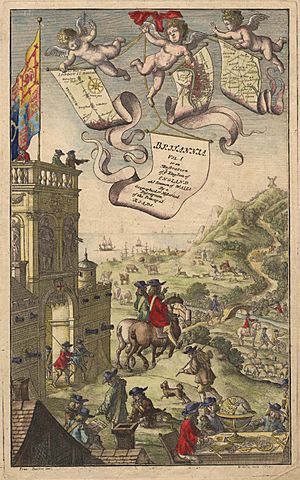Francis Barlow (artist) facts for kids
Quick facts for kids
Francis Barlow
|
|
|---|---|

Frontispiece: Ogilby's Britannia, Vol. I (1675)
|
|
| Born | c. 1626 Lincolnshire, England
|
| Died | 11 August 1704 (burial date, aged c. 78) |
| Nationality | English |
| Known for | Painting, etching, book illustration, comics |
Francis Barlow (born around 1626, died 1704) was a talented English artist. He was a painter, an etcher (someone who makes prints using acid), and an illustrator for books. He created many pictures for books and was one of the busiest printmakers in the 1600s.
Barlow is often called "the father of British sporting painting" because he was the first British artist to focus on painting wildlife. He also played a part in the early history of comics! He made a picture story called A True Narrative of the Horrid Hellish Popish Plot around 1682. This story used pictures with text underneath and even speech bubbles, which was very new for the time.
Contents
About Francis Barlow's Life
Francis Barlow was born in a place called Lincolnshire, England, around the year 1626. We don't know the exact day he died, but he was buried on August 11, 1704.
Francis Barlow's Art and Creations
Barlow's first big project was illustrating a book called Theophila in 1652. He created twelve special pictures for it. Some people even thought the pictures were more valuable than the words in the book!
Illustrating Aesop's Fables
Barlow also designed 110 woodcut pictures for John Ogilby's translation of Aesop's Fables, which came out in 1665. He even etched some of these pictures himself.
Painting Animals and Nature
Barlow was especially good at drawing birds, fish, and all kinds of animals. He drew them in a lively and skillful way. For example, he made drawings for a set of twelve prints by Wenceslaus Hollar in 1671. These prints showed "Several Ways of Hunting, Hawking, and Fishing."
Hidden Meanings in Wildlife Art
Sometimes, Barlow's wildlife paintings had deeper meanings. They weren't just beautiful pictures of animals. They could also show the worries and feelings of Britain after the English Civil War. For instance, his painting A Decoy was an allegory (a story with a hidden meaning) about the challenges facing England from Roman Catholicism.
Political Art and Satire
Before the Glorious Revolution, Barlow became a main artist for political satire that supported the Whigs. The Whigs were a political group at the time. A Whig Member of Parliament named Denzil Onslow bought or asked Barlow to create many paintings to decorate his home, Pyrford Court. These paintings later moved to Clandon Park and are one of the largest collections of Barlow's work that still exist today.
Where to See Barlow's Work
You can see examples of Francis Barlow's art at places like Ham House in London. His work is also kept in important museums such as Tate Britain, the National Portrait Gallery, the British Museum, and the Victoria and Albert Museum.
Barlow's Signature
Barlow often signed his artwork with his initials, F.B., instead of his full name. Sometimes he would even put his initials inside a small circle.
Why Francis Barlow is Important
Even though Francis Barlow was a very talented artist, he has sometimes been overlooked. Art historians explain that the time he lived in is often called a "forgotten era" in British art. This is because famous artists like Anthony van Dyck came before him, and artists like William Hogarth came after him. However, Barlow made a very important contribution to art during what was actually a rich and exciting time for visual arts in Britain.
Gallery
-
The Mice in Council, from Ogilby's translation of Aesop's Fables (1665)
-
Pack of playing cards depicting the Popish Plot, c. 1679; V&A Museum no. 20366: 1 to 52
See also
- English art
- List of British artists
Sources
- Article on the Lambiek Comiclopedia
- "Francis Barlow, c. 1626-1702"; From: A New General Biographical Dictionary, Projected and partly arranged by the late Rev. Hugh James Rose, B.D., Principal of King's College, London
- Hodnett, Edward. Francis Barlow: first master of English book illustration. London: Scolar, 1978. ISBN: 0-85967-350-2. Berkeley: University of California Press, 1978.
- https://www.lambiek.net/artists/b/barlow_francis.htm
- Attribution
 This article incorporates text from a publication now in the public domain: Bullen, Arthur Henry (1885). "Benlowes, Edward". Dictionary of National Biography 4. Ed. Leslie Stephen. London: Smith, Elder & Co.
This article incorporates text from a publication now in the public domain: Bullen, Arthur Henry (1885). "Benlowes, Edward". Dictionary of National Biography 4. Ed. Leslie Stephen. London: Smith, Elder & Co.




